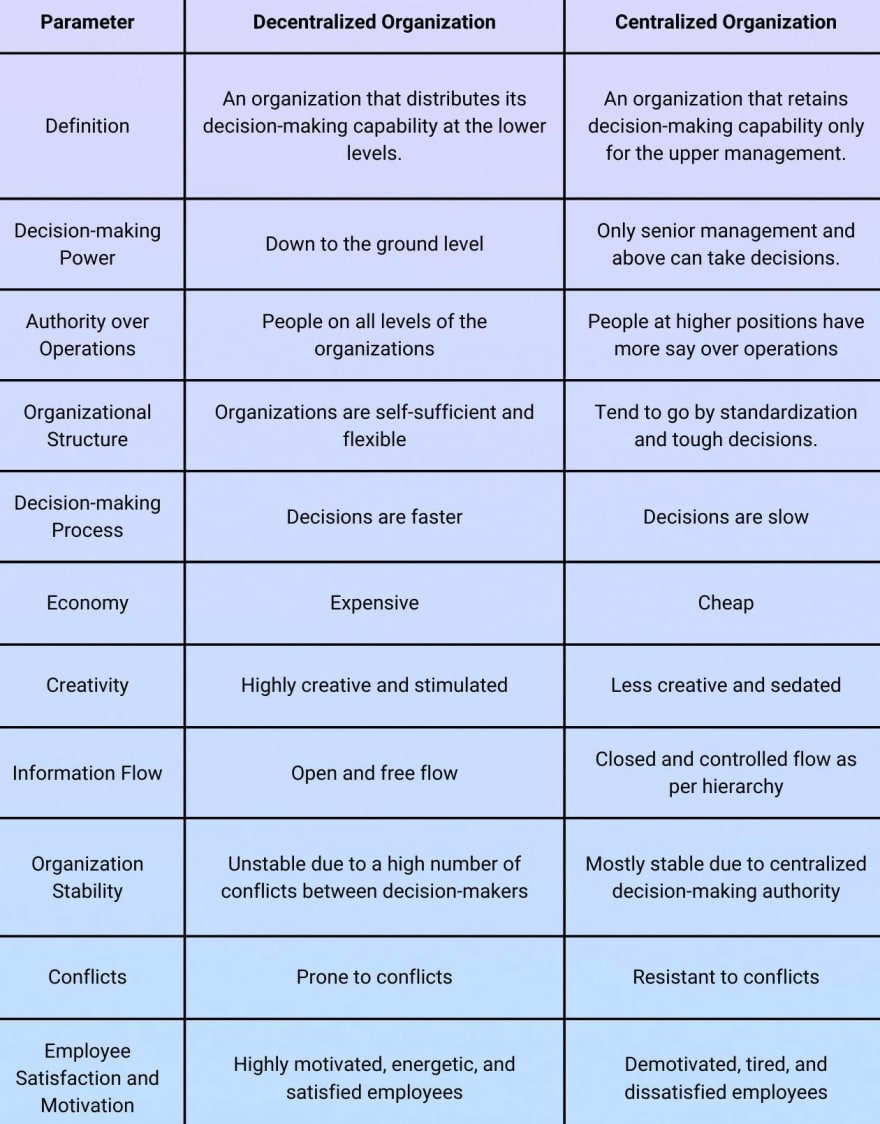If you look at many organizations and even startups that have become unicorns today, you might be amazed how many of them are advocates of keeping a centralized chain of command. Most of them vouch for centralization as the reason for their growth. However, what enterprises fail to factor in is the rise of technology. It demands more value and transparency to the user, which Web 3.0 aims to bring.
And one of the core driving factors of Web 3.0 is blockchain and decentralization. Many companies have benefited from a decentralized management approach, including Johnson and Johnson, one of the oldest in the decentralized organization arena. It helps in scaling faster and brings other organizational benefits such as controlled costs and an even lower attrition rate. Want to know how? Read on!
What is a Decentralized Organization?
In textbook definition words, companies that have allowed the flow of decision-making authority on all levels are called decentralized organizations. Organizations with local offices and employees with decision-making powers are decentralized in standard terms.
Broadly, decentralization began at the Government level where state-level representatives were appointed who further had district and county level representatives. It has now trickled down to the organizational level. In India, the first significant step toward decentralization happened in 1992.
Multinational conglomerates that have a high number of employees and have considerable business interests are the ones that use decentralization. It reduces decision-making pressure from the company's top management and helps develop leaders that can take the company forward in that particular region.
Additionally, it allows the administration to keep track of the competition they are improving in providing value to the customers. Decentralization offers enormous benefits leading to changes in business models and adapting to those changes.
Differences b/w Centralized and Decentralized Organizations
What exactly are the traits that differ between a conventional organization and a company based on the Web 3.0 ideology of decentralization? Here’s how:
Pros of Having a Decentralized Organization
- Organizations are self-sufficient
With decentralization; the pressure is distributed on all levels. Hence, the absence of a team member does not impact the overall productivity a lot. Consequently, even the top management can take off days which means that the organization is self-sufficient.
- Scaling is easier
Since the top management does not need to dive into the nitty-gritty details of the office operations of a particular location, scaling becomes easier. The command can easily hire capable local employees to handle day-to-day functions, which can help them to grow the business overall and not get stuck in micromanagement.
- Faster decision-making
Decentralization gives autonomy to managers at all levels of the organization. It means that the employees do not need to wait for approvals from senior management before taking on a task. This helps in faster decision-making, which increases overall productivity.
- Happier team members and business owners
The basic principle behind decentralization is to make employees at all levels capable and self-motivated. It means that they can find meaning and motivation through the work. This, in turn, keeps the team members and business owners happy.
- Strengthening leadership skills
By giving the power to make decisions from their own experience and wisdom, leadership qualities are inculcated into every individual. This helps in building better leaders for tomorrow.
- Subordinates motivation
When the employees know they are being valued and their skills developing in an all-round manner, their motivation will increase. Furthermore, it also helps increase the employee retention rate for the business.
- Efficient communication
Since the power to make decisions flows at all levels; the communication channels become more transparent and efficient for everyone. This improves clarity around tasks and helps form relationships that are not possible with a hierarchical structure of a centralized organization.
Cons of Having a Decentralized Organization
- Poor leadership can damage a company’s reputation
While some are born leaders, some have to learn it. And during this learning curve, they can take decisions that are detrimental to the company. While the mistake can be corrected, the damage to the company’s reputation is more difficult to remedy.
- Communication barriers
It is often said that too many cooks spoil the broth. With a decentralized organization, too much autonomy often results in communication barriers. This happens because everyone has their methodology and ideology to get the work done, which can often cause ambiguity about what way to take.
- Difficulty collaborating
Despite the improvement of communication channels, scheduling barriers still arise. Now, employees have to run in circles to check the availability of every individual to get work done.
- Team-wise expenses increase
To handle operations of various teams at every level, a manager is required. This means hiring costs and overall operational costs also increase.
- Service functions can waste resources
To serve employees at all levels, separate teams are often required. This can cause a surplus of resources and increase redundancies.
For instance, centralized organizations often use the same accounting and finance team for all employees, which helps get done more with fewer resources.
Read more examples of decentralization organization 2022 https://www.codemonk.ai/insights/decentralized-organization-guide








Top comments (0)